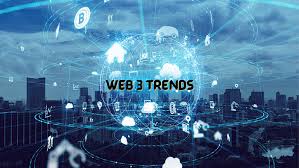Introduction: Web3 and the Rise of Digital Ownership
The internet is shifting from the centralized control of Web2 to the decentralized, user-owned model of Web3. In this new era, digital ownership isn’t just about NFTs—it’s about controlling your identity, assets, and interactions without relying on big corporations.
In 2025, Web3 innovations are not only maturing but also integrating into everyday life. From real estate to entertainment, these technologies are enabling secure, transparent, and verifiable ownership of both digital and physical assets.
Let’s explore the 6 key Web3 trends that are shaping this transformation.

Trend 1: Tokenized Real Estate
What it is:
Tokenized real estate uses blockchain to split property ownership into digital tokens, allowing fractional ownership and easier transfers.
Why it matters in 2025:
- Removes barriers for small investors.
- Enables 24/7 real estate trading similar to stock markets.
- Increases liquidity in traditionally illiquid markets.
Example:
A luxury apartment in New York is divided into 1,000 tokens. Each token represents 0.1% ownership, enabling anyone to invest with as little as $500.
| Feature | Traditional Real Estate | Tokenized Real Estate |
|---|---|---|
| Ownership Transfer | Weeks/Months | Minutes |
| Minimum Investment | Thousands of dollars | As low as $10 |
| Liquidity | Low | High |
| Transparency | Limited | Full blockchain record |
Impact on Digital Ownership:
Tokenized real estate makes physical assets digitally ownable and tradable without intermediaries.
Trend 2: Decentralized Identity (DID)
What it is:
A Decentralized Identity (DID) is a blockchain-based digital identity that users fully control without a central authority (like Google or Facebook).
Why it matters in 2025:
- Eliminates the need for multiple usernames and passwords.
- Reduces identity theft risks.
- Enables privacy-first authentication.
Example:
Instead of logging into a service with Facebook, you use your DID wallet, granting access only to the necessary data (e.g., your age, not your entire profile).
| Benefit | Description |
|---|---|
| Privacy | Share only required info. |
| Portability | Use across apps and services. |
| Security | Cryptographically secure. |
Impact on Digital Ownership:
DID puts personal data control back into the hands of individuals, ensuring you own your identity instead of tech giants.
Trend 3: NFT Evolution Beyond Art
What it is:
NFTs (Non-Fungible Tokens) in 2025 go far beyond art and collectibles—they’re now used for real-world assets, event tickets, supply chain tracking, and even medical records.
Why it matters in 2025:
- Expands utility beyond speculative art markets.
- Reduces counterfeiting in multiple industries.
- Creates verifiable proof of authenticity for physical goods.
Example:
A luxury watch comes with an NFT that stores manufacturing details, ownership history, and authenticity proof—making it impossible to sell a fake.
| Industry | NFT Application |
|---|---|
| Events | Fraud-proof tickets |
| Fashion | Proof of authenticity |
| Healthcare | Medical record ownership |
| Education | Blockchain-based diplomas |
Impact on Digital Ownership:
NFTs now bridge digital and physical ownership, making them functional tools rather than just collectibles.
Trend 4: DAO-Powered Communities
What it is:
DAOs (Decentralized Autonomous Organizations) are blockchain-based communities that make decisions collectively, without traditional corporate hierarchies.
Why it matters in 2025:
- Enables community-driven ownership.
- Improves transparency in decision-making.
- Reduces dependency on central leadership.
Example:
A DAO owns a virtual gaming world. Players vote on new game features, in-game economy changes, and content releases—ensuring that those who contribute have a say.
| Feature | Traditional Company | DAO |
|---|---|---|
| Decision Power | Executives only | Token holders |
| Transparency | Limited | Full on-chain |
| Profit Sharing | Shareholders only | Community members |
Impact on Digital Ownership:
DAOs shift ownership from corporations to communities, creating shared responsibility and benefits.
Trend 5: Metaverse Asset Ownership
What it is:
Owning virtual land, buildings, and digital goods in the metaverse using blockchain.
Why it matters in 2025:
- Metaverse economies are merging with real-world commerce.
- Businesses are setting up virtual stores to sell both digital and physical goods.
- People are monetizing virtual land through rentals, advertising, and events.
Example:
A clothing brand owns a metaverse store selling digital outfits as NFTs, which can also be redeemed for physical versions.
| Asset Type | Ownership Mechanism |
|---|---|
| Virtual Land | Blockchain deed |
| Digital Outfits | NFT ownership |
| In-game Weapons | Smart contracts |
Impact on Digital Ownership:
The metaverse transforms digital spaces into valuable, ownable real estate.
Trend 6: Cross-Chain Asset Portability
What it is:
Technology that allows assets (NFTs, tokens) to move seamlessly across different blockchains.
Why it matters in 2025:
- Removes barriers between blockchain ecosystems.
- Enhances liquidity for digital assets.
- Allows true digital ownership without platform lock-in.
Example:
An NFT bought on Ethereum can be used in a game that runs on Polygon, without losing authenticity or ownership rights.
| Problem Solved | Benefit |
|---|---|
| Platform lock-in | Freedom to move assets |
| Low liquidity | Larger trading market |
| Incompatibility | Interoperability |
Impact on Digital Ownership:
Cross-chain technology makes digital assets flexible, usable, and truly owned by the holder—not tied to one platform.
Challenges Facing Web3 Digital Ownership in 2025
Even with these advancements, Web3 digital ownership faces hurdles:
| Challenge | Description | Possible Solution |
|---|---|---|
| Regulatory Uncertainty | Governments still figuring out how to regulate blockchain ownership. | Clear legal frameworks for digital assets. |
| Cybersecurity Risks | Wallet hacks and phishing remain threats. | Better wallet security & education. |
| Scalability Issues | High transaction fees and slow processing. | Layer-2 scaling solutions. |
The Future of Digital Ownership Beyond 2025
By 2030, we may see:
- Government-issued IDs as DIDs on blockchain.
- Universal NFT standards for both digital and physical goods.
- Metaverse-city partnerships for virtual governance.
Conclusion
The 6 Web3 trends of 2025—tokenized real estate, decentralized identity, NFT utility, DAO-powered communities, metaverse ownership, and cross-chain portability—are redefining what it means to own something in the digital age.
Digital ownership is no longer about holding files or accounts—it’s about having provable, transferable, and unrestricted rights over both physical and virtual assets.
For individuals, this means more control. For businesses, it means new revenue models. And for society, it signals a shift toward decentralization and transparency.





